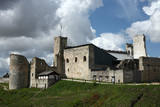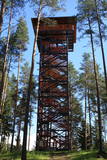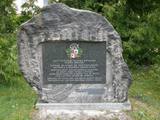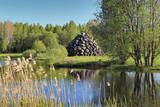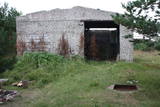| Нo | Название | Описание |
|---|---|---|
|
В замке турист оказывается в тематическом парке, представляющем жизнь и быт в замке 16-го века, где можно всей семьей провести захватывающий день, перевоплотиться в рыцарей и воинов. В замке можно покататься верхом, поупражняться в стрельбе из лука и арбалета, попробовать себя в профессиях кузнеца и плотника, чеканить монету, приготовить золото и порох. Открыты винный погреб, камера пыток, комната смерти, средневековый притон, мастерские цирюльника, алхимика, астронома. Расположенная в крепости корчма Шенкенберга предлагает блюда, приготовленные по средневековым рецептам. |
||
|
Atrodas 6,5 km ziemeļos no Cirgaļiem, P 23 ceļa malā, Ziemeļgaujas aizsargājamo ainavu apvidū. Torni vērts apmeklēt pavasara laikā, kad no tā redzamas applūdušas Gaujas palienes. |
||
|
Маршрут объединяет все многообразие Видземе и пролегает как вдоль морского побережья, так и по извилистым дорогам возвышенности с просторными живописными видами. Особенно подходит для семей с детьми. Информация о маршруте от Latvijas Lauku forums |
||
|
Atrodas Rucavas galvenās ielas malā, netālu no centra.Rucavas draudzi dibināja 1871. gadā, bet izmēros nelielo dievnamu uzcēla 1888. gadā. |
||
|
Находится в сквере возле Скрундского дома культуры. Установлен в 2005-м году в честь победы полковника О. Калпака и его батальона над большевиками в Скрундском бою. Во время Борьбы за независимость Латвии 22-го января 1919-го года большевики захватили Скрунду. 29-го января батальон Калпака из Рудбаржского поместья выступил в направлении Скрунды. После трехчасового боя он одержал победу, захватив стратегическую позицию вдоль берега Венты. Это была первая победа батальона Калпака после многократных отступлений, что вдохновило на дальнейшую Борьбу за независимость Латвии. |
||
|
Спокойное место на лоне природы, где можно отлично отдохнуть. Из доступных в окрестностях Хийумаа продуктов здесь готовят различные блюда, следуя пожеланиям гостей. Кроме того, здесь можно насладиться аутентичной сауной с дровяным отоплением, искупаться в бочке, а для детей оборудована игровая площадка. |
||
|
Iespēja ielūkoties audējas, rokdarbnieces, ekoloģisko rotaļlietu radītājas, tekstilmākslinieces projekta “100 deči Latvijai” autores Anneles Slišānes senajās Latgales lauku mājās.
|
||
|
Полюбившееся место в центре Огре. Находятся в здании, построенном до Первой мировой войны, где в советское время размещался участок милиции. Предлагают музыкальные вечера. Латышская кухня: Сырное ассорти из сыров «Сиерштеллес», суп из баранины, грибной суп, перловая каша с грибами, филе сома, сорбет из лесных ягод, блины. Особое блюдо: запеченное сырное пирожное с ягодами. |
||
|
«Сердце Латгалии», где в XIV - XII вв. поднялся укрепленный латгальский замок. На месте латгальского замка в 1285 году Ливонский орден приступил к строительству каменного замка. После крушения Ливонии (Резекне вошел в составе Польши) город находился в запущении. Экономическая жизнь в Резекне возобновилась во второй половине XVIII столетия. Со строительством шоссе Санкт-Петербург – Варшава (1836 г.) и железнодорожной ветки Санкт-Петербург – Варшава (1861 г.) Резекне становится пунктом назначения отдыхающих из Санкт-Петербурга. В годы Второй мировой войны существенно пострадала большая часть построек города. Современный город – это важный экономический и культурный центр Латгалии. |
||
|
Старейший дендрарий Латвии (основан в 1891 г.), посадки которого спланировал и сформировал владелец Скриверской господской усадьбы Максимилиан фон Сиверс (1857 – 1919 гг.). Сейчас в парке насчитывается примерно 300 видов и сортов растений. Насаждения сгруппированы по месту их естественного роста - для различных мировых геоботанических районов. Для удобства посетителей проложены дорожки, а рядом с растениями находятся дощечки с названиями. Фонтан работает со вторника по воскресенье. На другой стороне шоссе Рига – Даугавпилс (А6) находится Скриверский лесной парк с прогулочными тропами. |
||
|
Кафе «Баравика» находится в центре города Резекне. В кафе представлен широкий выбор всевозможных блюд. Время работы: пн. – пт.: с 8:30 до18:00. |
||
|
Here the visitor will find an ecological tourism trail in the ancient Embūte valley. The hills around Embūte date back to the Ice Age. There are valleys and forests of many fallen trees which are protected habitats. The visitor will learn about important natural and cultural monuments – the Embūte castle hill, as well as the ruins of a baronial estate, a castle and a church. The Courlandian chieftain Indulis died in the region. The visitor can view the Devil’s Dam, along with meadows, a viewing tower, etc. There are bicycler routes in the region. The site is located in the Embūte nature park. |
||
|
Bioloģiskā saimniecība nodarbojas ar Irbeņu ogu audzēšanu un dažādu to produktu ražošanā kā pulverus, sulas, tinktūras, eļļas, sejas maskas un kapsulas. Irbene ir vērtīgs ārstniecības augs, kur izmantojamas ir pilnīgi visas tā daļas – lapas, ogas, sēklas, stumbrs, miza, sakne un ziedi. |
||
|
In mid-summer, the farm features the beautiful blooms of rapeseed and flax. A special facility for pressing rapeseed and flax seed oil is on site. You can watch the oil pressing process and purchase some of the resulting oil.
|
||
|
Нагромождение валунов высотой 9 метров является своего рода памятником Кришьяну Барону и его достижениям на благо латышского народа. В Валпенском имении жила мать К. Барона и будущий Отец дайн. На камнях высечены названия исчезнувших домов. Их направление в каменной пирамиде указывает на бывшее местонахождение домов. Автор идеи Валпенской пирамиды – Имантс Зиедонис, скульптор – Вилнис Титанс. |
||
|
Хозяин свое пчеловодческое хозяйство основал на красивом берегу озера, на месте старинного жилья, расположив пчелиные улья в двух местах – на приозерном холме и на красивом лесном лугу, который хозяин преобразовал сам. Рядом с пасекой находится красивый яблоневый сад, в котором осенью хозяин рад видеть помощников. С 1996 года хозяин понемногу обновлял и ухаживал за этим хозяйстом, в котором уже красивое широкое озеро, домик у озера, клеть с отремонтированным помещением над клетью и балконом, пасека и яблоневый сад. |
||
|
Название Цесвайне в письменных источниках впервые упомянуто 1209 году. Для каждого путешественника Латвии город связан с родом барона Вульфа, который в 1815 году приобрел имение Цесвайне. Экономический расцвет Цесвайне наступил после строительства железной дороги Плявиняс - Гулбене. Город пострадал во время Второй мировой войны. В конце 2002 года в Цесвайнском дворце произошла трагедия - пожар, который затронул большую часть дворца. Благодаря большой поддержке общественности, государства и самоуправления Цесвайнский дворец обрел и по-прежнему сохраняет статус туристического объекта Видземского и Латвийского масштаба. |
||
|
Трактир Kaali на протяжении долгих лет предлагает своим гостям лучшие блюда и напитки эстонской и сааремской кухни, приготовленные из местных продуктов, а также знакомит с культурой и историей острова. Посетители музея и метеоритного кратера Каали могут здесь вкусно перекусить. |
||
|
В пункте погранохраны берега Лабрагс сохранились помещения для прожекторов. Объект находится в частной собственности.
|
||
|
Хозяйка по старинным рецептам на кленовых листьях выпекает хлеб и скландрауши, состоящие из трех слоев (ржаная мука, картофель и морковь). Демонстрирует процесс выпечки хлеба и скландраушей, предлагает попробовать или купить готовую продукцию. |
||
